Abstract
This report describes the effects of pharmacologic doses (3 g/d) of nicotinic acid on the plasma distribution and chemical composition of the high density lipoprotein (HDL) subfractions HDL2 and HDL3 and examines the influence of the drug on the metabolism of the major HDL apoproteins, apolipoproteins A-I (ApoA-I) and A-II (Apo-II).
The drug lowered plasma cholesterol (15%, P < 0.05) and triglyceride (27%, P < 0.01); the former effect a result of a fall in the amount of cholesterol associated with very low density lipoproteins (31%, P < 0.02) and low density lipoproteins (36%, P < 0.02). Conversely, it raised plasma HDL cholesterol (23%, P < 0.05) and increased (by 345%) the plasma HDL2:HDL3 ratio. The latter derived from an absolute increment (646%) in circulating HDL2, coupled with a fall (47%) in HDL3. This change was not associated with major alterations in the overall cholesterol (free and esterified), triglyceride, phospholipid, or protein content of the subfractions; however, it was accompanied by substantial changes in their protein composition. In particular, the molar ratio of ApoA-I:ApoA-II in HDL3 declined from 2.7:1 to 2.1:1 during nicotinic acid treatment.
Significant perturbations of ApoA-I and ApoA-II metabolism accompanied the drug-induced HDL subfraction redistribution. Specifically, the plasma concentration of ApoA-I rose by 7% (P < 0.05) because of a decrease in its fractional catabolic rate. Moreover, whereas before treatment 6 and 94% of the plasma ApoA-I circulated with HDL2 and HDL3, after commencement of nicotinic acid therapy this distribution became 49 and 51% in HDL2 and HDL3, respectively. ApoA-II was found mainly in HDL3, both before and during nicotinic acid treatment. Administration of the drug caused a 14% reduction in its plasma concentration (P < 0.05), which derived principally from a fall (22%, P < 0.01) in its synthetic rate.
These data suggest that the effects of nicotinic acid on the HDL subfraction distribution may be mediated via (a) net transfer of ApoA-I from HDL3 to HDL2 and (b) a reduction in ApoA-II synthesis. Our present understanding of the association between HDL and atherosclerosis indicates that such changes may have prophylactic value in the prevention of coronary artery disease.
Full text
PDF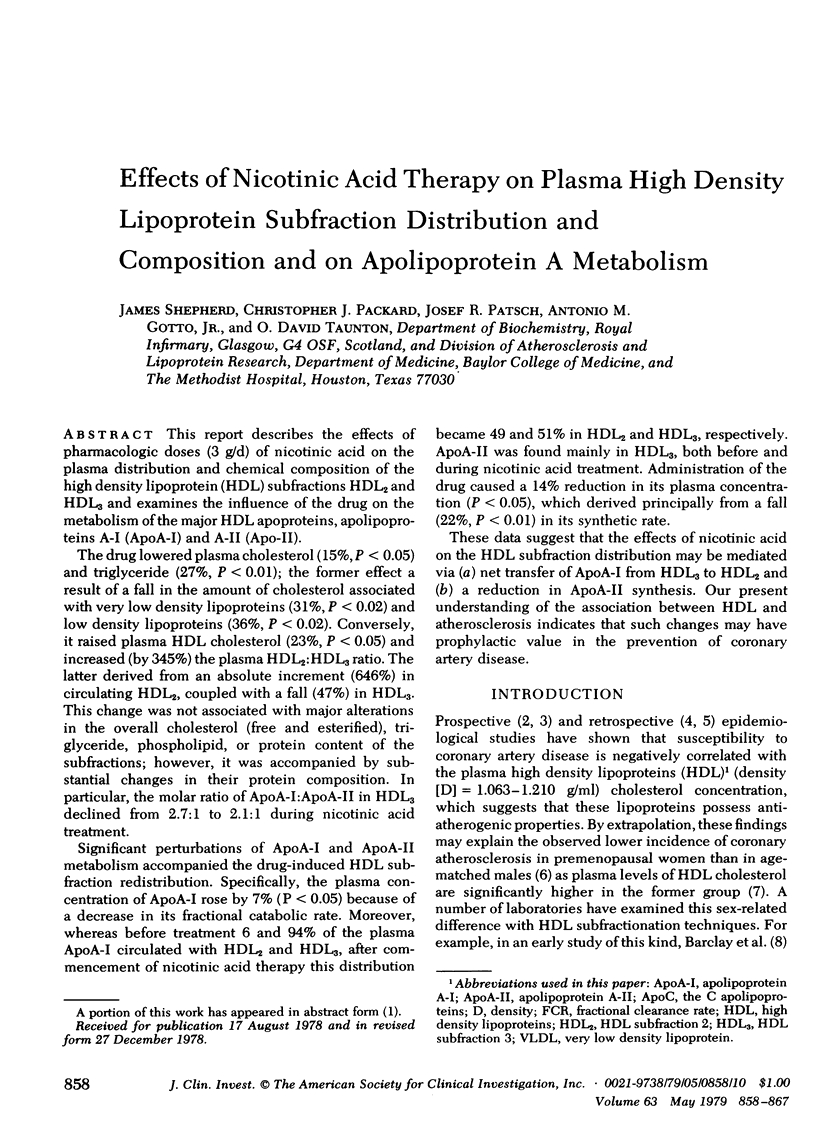

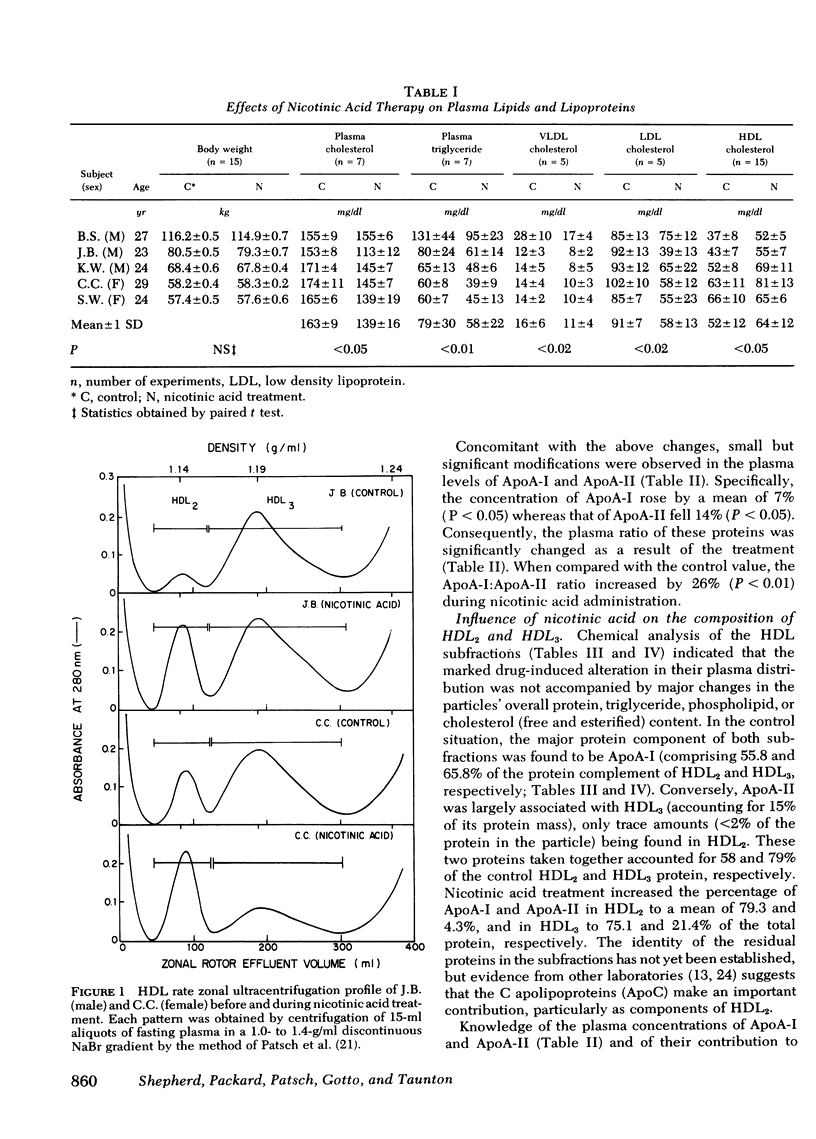
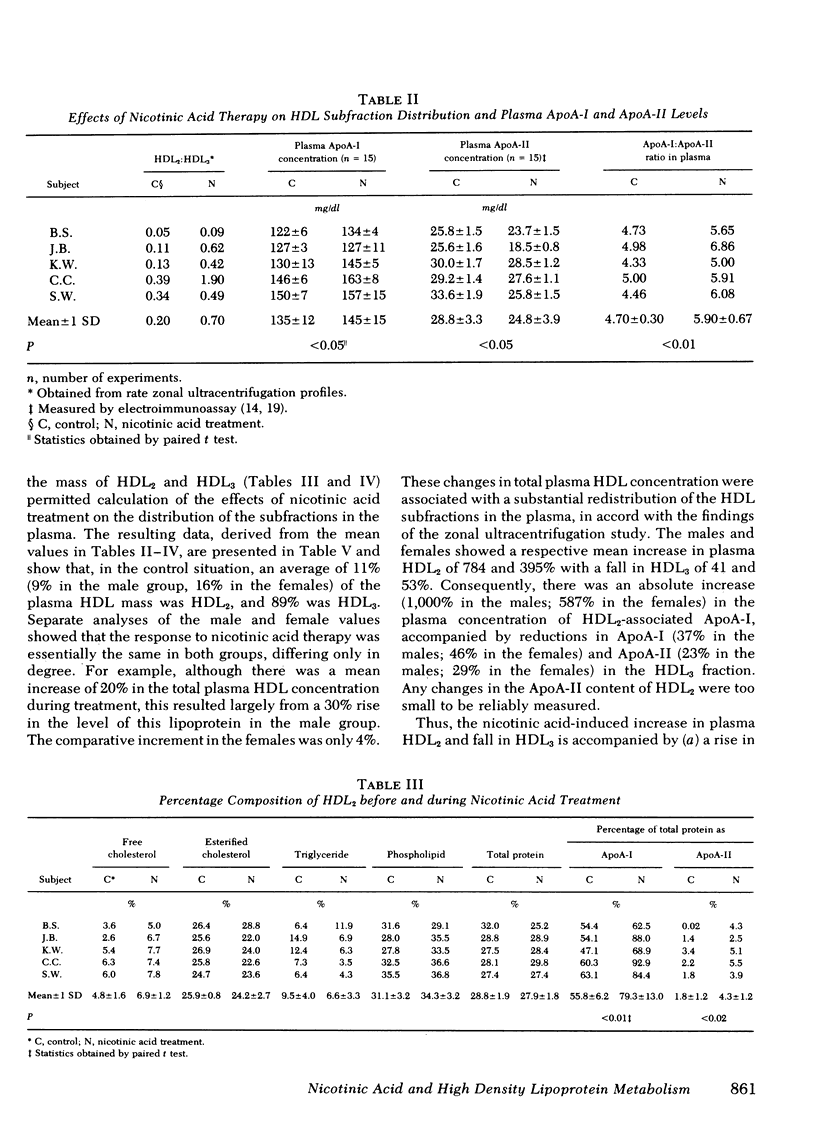
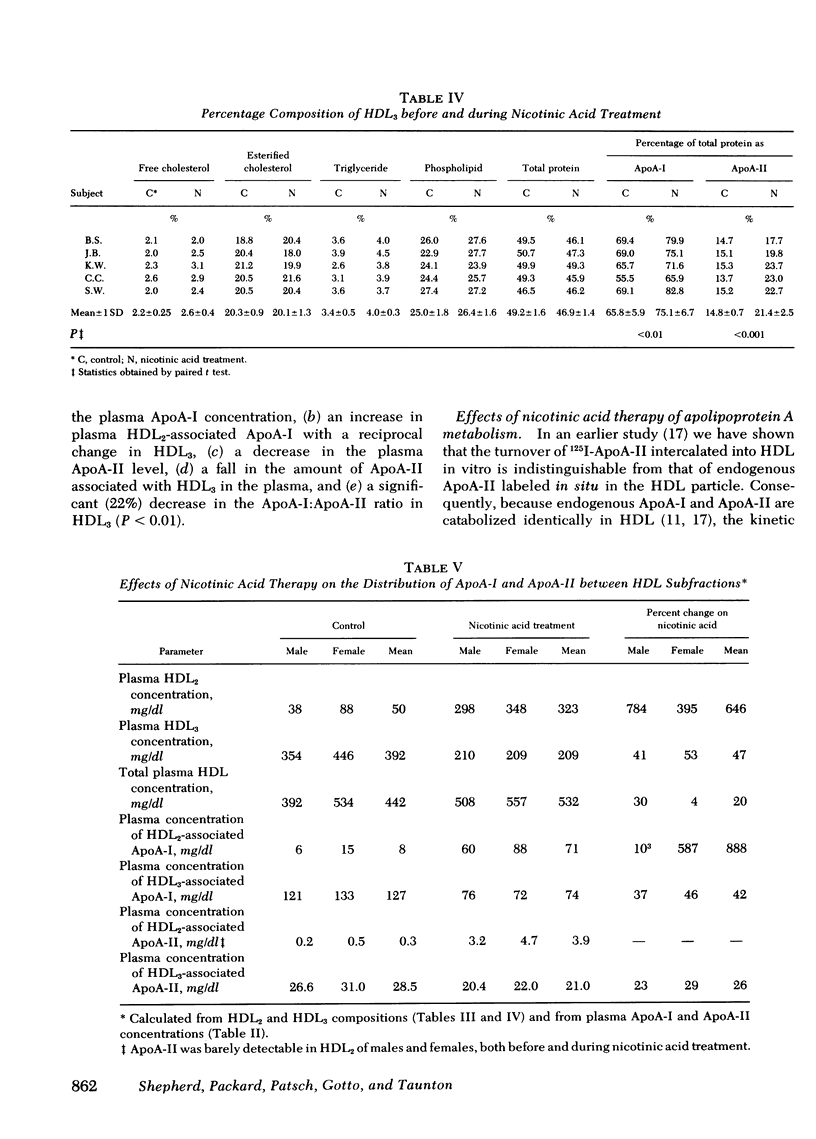
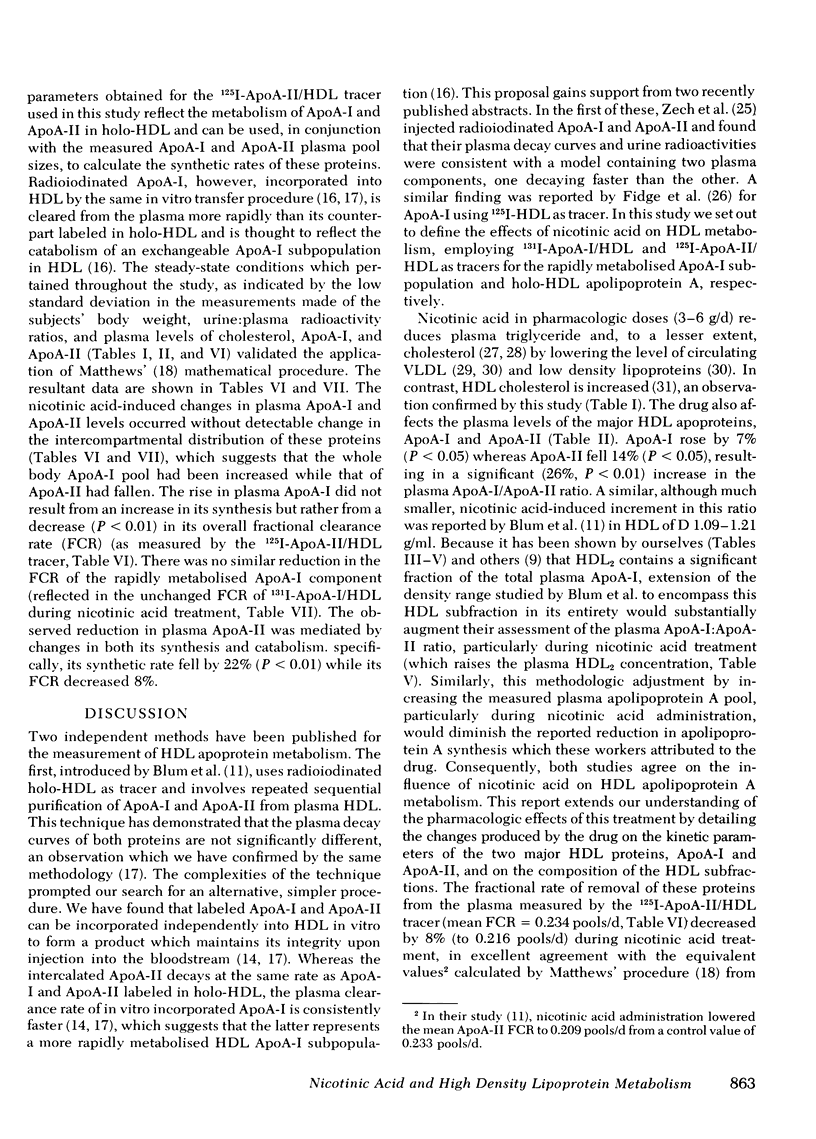
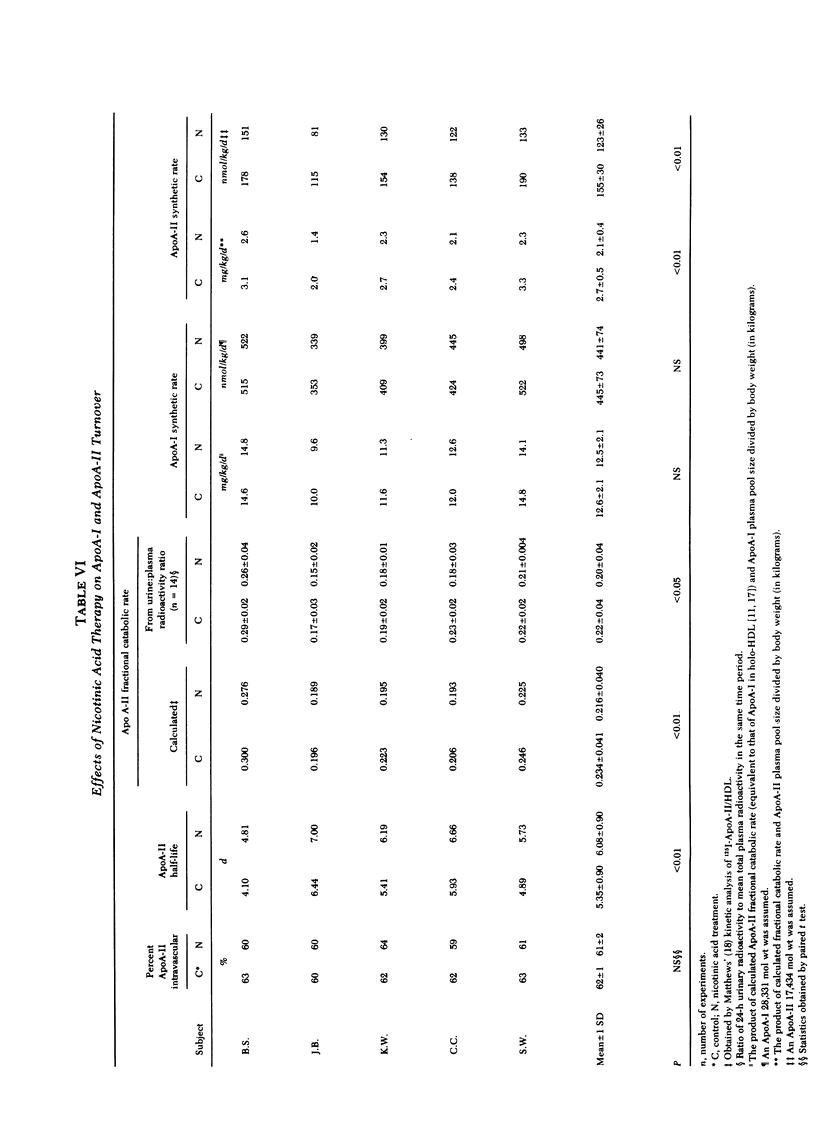
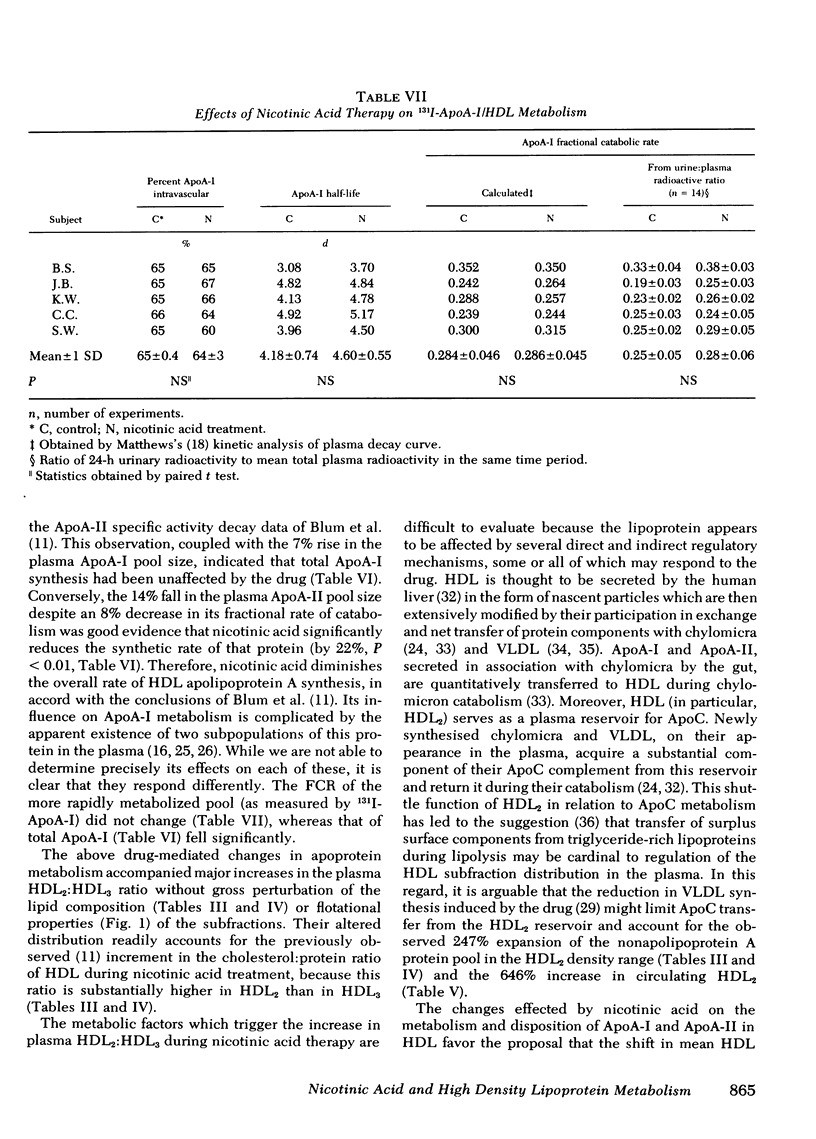
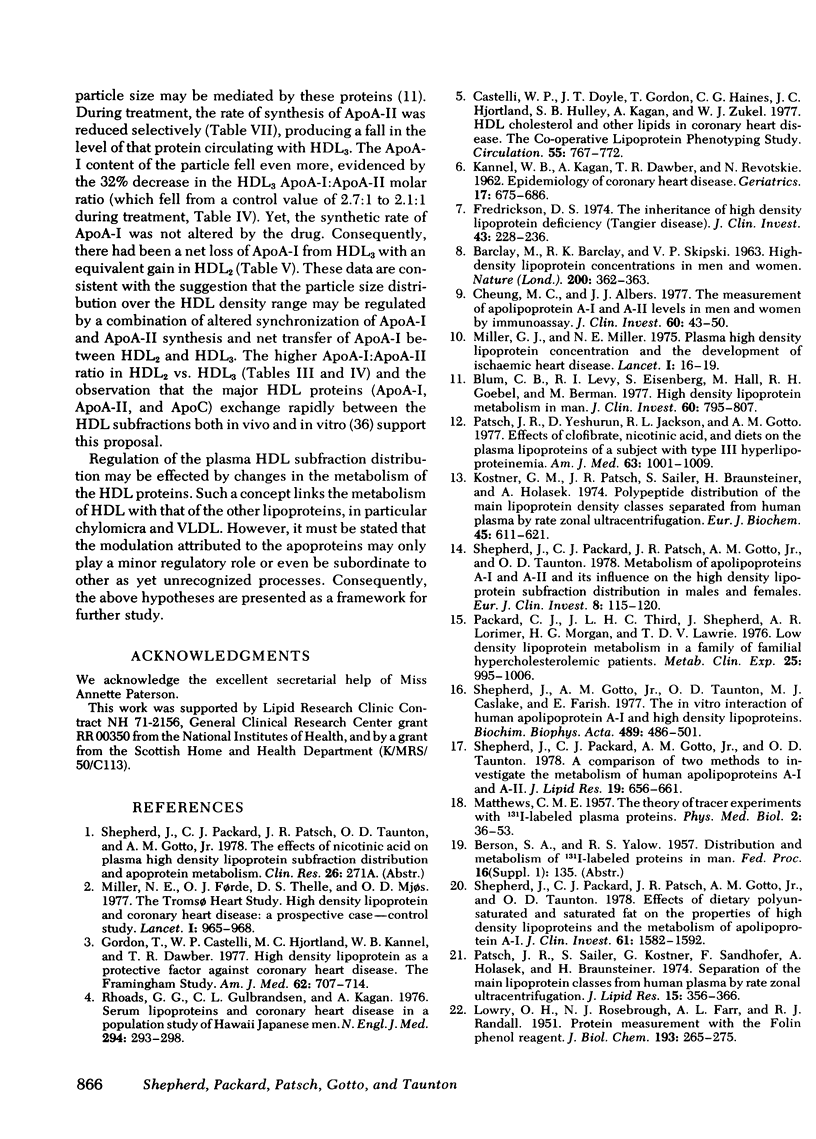
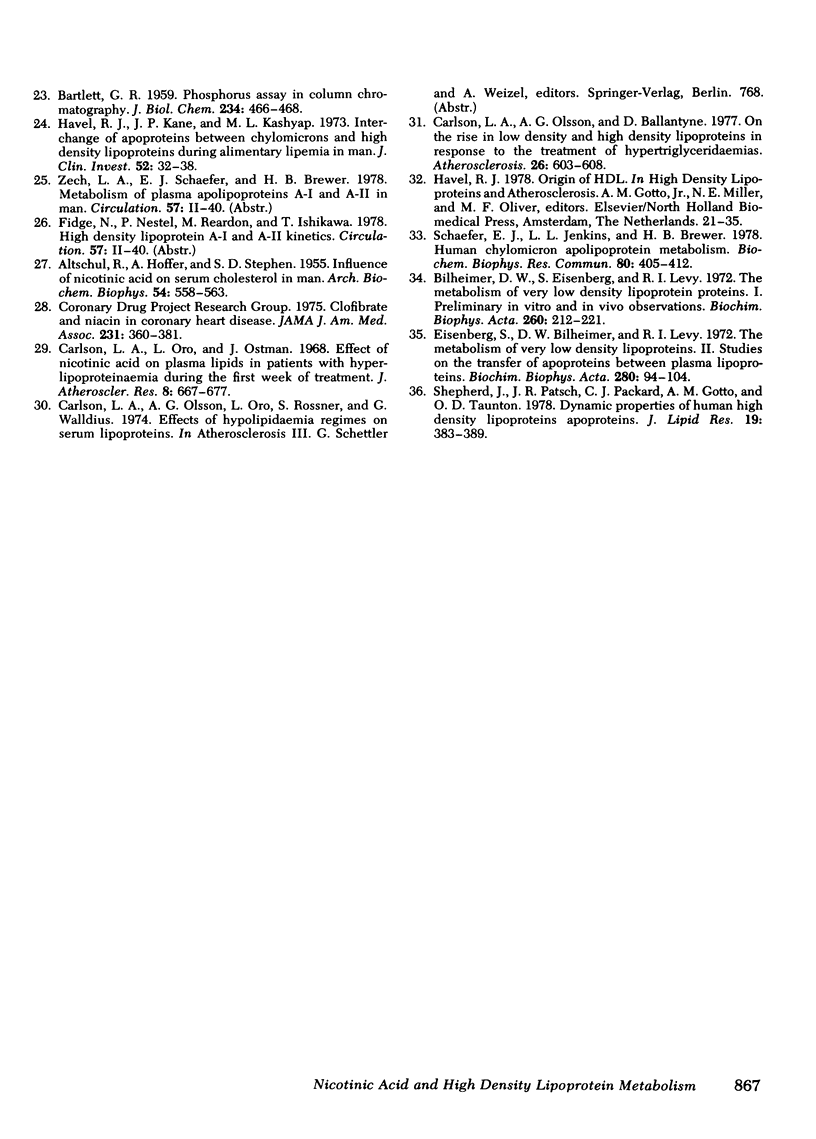
Selected References
These references are in PubMed. This may not be the complete list of references from this article.
- ALTSCHUL R., HOFFER A., STEPHEN J. D. Influence of nicotinic acid on serum cholesterol in man. Arch Biochem Biophys. 1955 Feb;54(2):558–559. doi: 10.1016/0003-9861(55)90070-9. [DOI] [PubMed] [Google Scholar]
- BARCLAY M., BARCLAY R. K., SKIPSKI V. P. HIGH-DENSITY LIPOPROTEIN CONCENTRATIONS IN MEN AND WOMEN. Nature. 1963 Oct 26;200:362–363. doi: 10.1038/200362b0. [DOI] [PubMed] [Google Scholar]
- BARTLETT G. R. Phosphorus assay in column chromatography. J Biol Chem. 1959 Mar;234(3):466–468. [PubMed] [Google Scholar]
- Bilheimer D. W., Eisenberg S., Levy R. I. The metabolism of very low density lipoprotein proteins. I. Preliminary in vitro and in vivo observations. Biochim Biophys Acta. 1972 Feb 21;260(2):212–221. doi: 10.1016/0005-2760(72)90034-3. [DOI] [PubMed] [Google Scholar]
- Blum C. B., Levy R. I., Eisenberg S., Hall M., 3rd, Goebel R. H., Berman M. High density lipoprotein metabolism in man. J Clin Invest. 1977 Oct;60(4):795–807. doi: 10.1172/JCI108833. [DOI] [PMC free article] [PubMed] [Google Scholar]
- Carlson L. A., Olsson G., Ballantyne D. On the rise in low density and high density lipoproteins in response to the treatment of hypertriglyceridaemias in type IV and type V hyperlipoproteinaemias. Atherosclerosis. 1977 Apr;26(4):603–609. doi: 10.1016/0021-9150(77)90127-7. [DOI] [PubMed] [Google Scholar]
- Carlson L. A., Orö L., Ostman J. Effect of nicotinic acid on plasma lipids in patients with hyperlipoproteinemia during the first week of treatment. J Atheroscler Res. 1968 Jul-Aug;8(4):667–677. doi: 10.1016/s0368-1319(68)80025-0. [DOI] [PubMed] [Google Scholar]
- Castelli W. P., Doyle J. T., Gordon T., Hames C. G., Hjortland M. C., Hulley S. B., Kagan A., Zukel W. J. HDL cholesterol and other lipids in coronary heart disease. The cooperative lipoprotein phenotyping study. Circulation. 1977 May;55(5):767–772. doi: 10.1161/01.cir.55.5.767. [DOI] [PubMed] [Google Scholar]
- Cheung M. C., Albers J. J. The measurement of apolipoprotein A-I and A-II levels in men and women by immunoassay. J Clin Invest. 1977 Jul;60(1):43–50. doi: 10.1172/JCI108767. [DOI] [PMC free article] [PubMed] [Google Scholar]
- Eisenberg S., Bilheimer D. W., Levy R. I. The metabolism of very low density lipoprotein proteins. II. Studies on the transfer of apoproteins between plasma lipoproteins. Biochim Biophys Acta. 1972 Sep 7;280(1):94–104. [PubMed] [Google Scholar]
- FREDRICKSON D. S. THE INHERITANCE OF HIGH DENSITY LIPOPROTEIN DEFICIENCY (TANGIER DISEASE). J Clin Invest. 1964 Feb;43:228–236. doi: 10.1172/JCI104907. [DOI] [PMC free article] [PubMed] [Google Scholar]
- Gordon T., Castelli W. P., Hjortland M. C., Kannel W. B., Dawber T. R. High density lipoprotein as a protective factor against coronary heart disease. The Framingham Study. Am J Med. 1977 May;62(5):707–714. doi: 10.1016/0002-9343(77)90874-9. [DOI] [PubMed] [Google Scholar]
- Havel R. J., Kane J. P., Kashyap M. L. Interchange of apolipoproteins between chylomicrons and high density lipoproteins during alimentary lipemia in man. J Clin Invest. 1973 Jan;52(1):32–38. doi: 10.1172/JCI107171. [DOI] [PMC free article] [PubMed] [Google Scholar]
- KANNEL W. B., KAGAN A., DAWBER T. R., REVOTSKIE N. Epidemiology of coronary heart disease. Implications for the practicing physician. Geriatrics. 1962 Oct;17:675–690. [PubMed] [Google Scholar]
- Kostner G. M., Patsch J. R., Sailer S., Braunsteiner H., Holasek A. Polypeptide distribution of the main lipoprotein density classes separated from human plasma by rate zonal ultracentrifugation. Eur J Biochem. 1974 Jun 15;45(2):611–621. doi: 10.1111/j.1432-1033.1974.tb03587.x. [DOI] [PubMed] [Google Scholar]
- LOWRY O. H., ROSEBROUGH N. J., FARR A. L., RANDALL R. J. Protein measurement with the Folin phenol reagent. J Biol Chem. 1951 Nov;193(1):265–275. [PubMed] [Google Scholar]
- MATTHEWS C. M. The theory of tracer experiments with 131I-labelled plasma proteins. Phys Med Biol. 1957 Jul;2(1):36–53. doi: 10.1088/0031-9155/2/1/305. [DOI] [PubMed] [Google Scholar]
- Miller G. J., Miller N. E. Plasma-high-density-lipoprotein concentration and development of ischaemic heart-disease. Lancet. 1975 Jan 4;1(7897):16–19. doi: 10.1016/s0140-6736(75)92376-4. [DOI] [PubMed] [Google Scholar]
- Miller N. E., Thelle D. S., Forde O. H., Mjos O. D. The Tromsø heart-study. High-density lipoprotein and coronary heart-disease: a prospective case-control study. Lancet. 1977 May 7;1(8019):965–968. doi: 10.1016/s0140-6736(77)92274-7. [DOI] [PubMed] [Google Scholar]
- Packard C. J., Third J. L., Shepherd J., Lorimer A. R., Morgan H. G., Lawrie T. D. Low density lipoprotein metabolism in a family of familial hypercholesterolemic patients. Metabolism. 1976 Sep;25(9):995–1006. doi: 10.1016/0026-0495(76)90129-3. [DOI] [PubMed] [Google Scholar]
- Patsch J. R., Sailer S., Kostner G., Sandhofer F., Holasek A., Braunsteiner H. Separation of the main lipoprotein density classes from human plasma by rate-zonal ultracentrifugation. J Lipid Res. 1974 Jul;15(4):356–366. [PubMed] [Google Scholar]
- Patsch J. R., Yeshurun D., Jackson R. L., Gotto A. M., Jr Effects of clofibrate, nicotinic acid and diet on the properties of the plasma lipoproteins in a subject with type III hyperlipoproteinemia. Am J Med. 1977 Dec;63(6):1001–1009. doi: 10.1016/0002-9343(77)90555-1. [DOI] [PubMed] [Google Scholar]
- Rhoads G. G., Gulbrandsen C. L., Kagan A. Serum lipoproteins and coronary heart disease in a population study of Hawaii Japanese men. N Engl J Med. 1976 Feb 5;294(6):293–298. doi: 10.1056/NEJM197602052940601. [DOI] [PubMed] [Google Scholar]
- Schaefer E. J., Jenkins L. L., Brewer H. B., Jr Human chylomicron apolipoprotein metabolism. Biochem Biophys Res Commun. 1978 Jan 30;80(2):405–412. doi: 10.1016/0006-291x(78)90691-5. [DOI] [PubMed] [Google Scholar]
- Shepherd J., Gotto A. M., Jr, Taunton O. D., Caslake M. J., Farish E. The in vitro interaction of human apolipoprotein A-I and high density lipoproteins. Biochim Biophys Acta. 1977 Dec 21;489(3):486–501. doi: 10.1016/0005-2760(77)90169-2. [DOI] [PubMed] [Google Scholar]
- Shepherd J., Packard C. J., Gotto A. M., Jr, Taunton O. D. A comparison of two methods to investigate the metabolism of human apolipoproteins A-I and and A-II. J Lipid Res. 1978 Jul;19(5):656–661. [PubMed] [Google Scholar]
- Shepherd J., Packard C. J., Patsch J. R., Gotto A. M., Jr, Taunton O. D. Effects of dietary polyunsaturated and saturated fat on the properties of high density lipoproteins and the metabolism of apolipoprotein A-I. J Clin Invest. 1978 Jun;61(6):1582–1592. doi: 10.1172/JCI109078. [DOI] [PMC free article] [PubMed] [Google Scholar]
- Shepherd J., Packard C. J., Patsch J. R., Gotto A. M., Jr, Taunton O. D. Metabolism of apolipoproteins A-I and A-II and its influence on the high density lipoprotein subfraction distribution in males and females. Eur J Clin Invest. 1978 Jun;8(3):115–120. doi: 10.1111/j.1365-2362.1978.tb00823.x. [DOI] [PubMed] [Google Scholar]
- Shepherd J., Patsch J. R., Packard C. J., Gotto A. M., Jr, Taunton O. D. Dynamic properties of human high density lipoprotein apoproteins. J Lipid Res. 1978 Mar;19(3):383–389. [PubMed] [Google Scholar]


